Hiking Bright Angel Trail To Plateau Point At The Grand Canyon
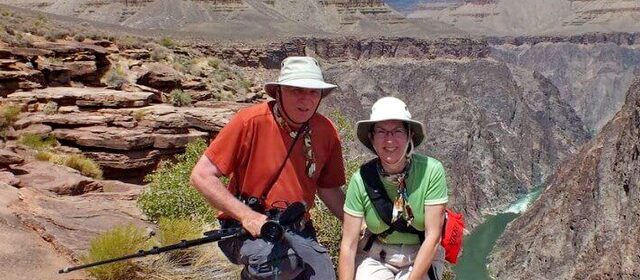
When Bob and I decided to hike Bright Angel Trail, we knew it would be a demanding challenge, and one that would take many hours. From the South Rim, Plateau Point was a speck at the edge of the Tonto Platform; from midway down the fault line, the narrow meandering trail that leads from Indian Garden to Plateau Point was more discernible but no less intimidating.
We had arrived at Indian Garden at Grand Canyon National Park at around 9:15 a.m., over 4 hours from the time we first set foot on Bright Angel Trail, and the welcome shade provided there by soaring Cottonwood Trees was relished by both Bob and me. After enjoying our first lunch of the day, we proceeded to soak our neckerchiefs and hats in the cold water of the nearby pond in preparation for hiking across the open desert.
To reach Indian Garden, Bob and I had hiked 4.6 miles from the trailhead by Bright Angel Lodge, and next we planned to strike out for Plateau Point, a further 1.5 miles on the fully sun-exposed Tonto Platform.
It was daunting, leaving the cool enclave of the oasis behind as we knew that it would be at least another couple of hours before we would be back at this welcoming rest spot.
It only took moments before the lush, green vegetation of the oasis was left in the distance behind us, but even as the plant life changed, we were stricken by its beauty. A tall stalk of Utah Agave dwarfed Bob’s 6-foot stature, its bulbous yellow flowers bobbing in the wind. These plants in some instances achieve a height of 4 metres.
A little further along, I was very surprised when a small group of Mule Deer emerged from the shadow of a bush just beside the trail. I had not expected to see such significant wildlife in the Tonto Desert…lizards and snakes perhaps, but not large mammals.
The Tonto Platform supports only those plants typical of a desert environment…low scrub, cacti and dwarfed trees, but being in close proximity to the water at Indian Garden, these deer are able to eke out an existence during the months between fall and late spring. During the summer, they are apt to move to higher and cooler ground. At the time we observed the deer, they were preparing to spend the heat of the day protected from the sun.
I did not spare much time to photograph the deer. The relentless sun beat down on us while the mercury sat at 90 F under very windy conditions. It felt more like 100 F, and what moisture the sun didn’t suck from our bodies, the ever-present wind surely did. I was on a mission to get to Plateau Point before the temperature peaked for the day.
The dry, sandy world of the Tonto Desert possesses a beauty all its own. The whole arid zone is covered with a number of species of cacti as well as Banana Yucca (Yucca baccata), Mojave Yucca (Yucca schidigera), and Cat Claw Acacia (Acacia greggii), all combining to add interest and texture to the otherwise rocky, barren land.
When Bob and I started to come across some of the cactus plants, it really reinforced the fact that we were in a desert. It was mid-June when we traveled to the Grand Canyon, so many of the cacti, such as these California Barrel Cacti, were in bloom.
California Barrel Cacti usually grow in a cylindrical or spherical shape that is heavily covered in long, sharp spines. The spines are red when new, turning to grey as they age, and starting out straight, they become curved over time. The flowers of these cacti have a maroon flush on the outside…
and bright yellow on the inside with either a red or yellow center. Oddly enough, the flowers grow on the side of the plant that faces the sun even though on the desert, you would think that would not be an issue . The vibrant yellow flowers, in combination with the red spines on top of the cacti, transformed the otherwise monotone landscape into a scene awash in colour.
There are so many subspecies of cacti in the Inner Canyon, that assigning those in our pictures to any specific category is very difficult. The cacti growing in Grand Canyon National Park have very interesting names that either reflect the shape of their pads, structure of their spines, or the colour of the flowers. Fishhook Barrel Cactus and Claretcup Hedgehog Cactus are two species of plants with very fanciful yet apt names.
Prickly Pear Cacti dotted the desert with some reaching heights as tall as me. There are about 200 species of Prickly Pear Cacti in the Americas. What distinguishes species of the Opuntia genus is that the plants have flat, fleshy pads that grow from the stem of the plant. These look like leaves, but they are actually flattened branches or stems that replace leaves for the purposes of photosynthesis. These flattened organs give rise to the plant’s’ alternate name: paddle cactus.
The rainbow of colours found in this sprawling community of Prickly Pear Cacti transformed the sandy desert floor into a thing of beauty. A characteristic trait of Opuntia is its nature to spread into large clonal colonies. The primarily green pads of these cacti were tinged with pale shades of pink, yellow, orange and mauve.
Upon closer inspection, we could see that some of the cacti still had evidence of their spring bloom in the withering flowers atop the vibrant pink fruit. It is this fruit of Prickly Pear Cacti that is a favoured treat eaten by not only humans, but certain birds and animals as well. Because of the small hair-like spines, called glochids, on the cactus fruit, great care must be taken to either peel the fruit or abrade it to remove the prickles before it is ingested.
In this closeup of a Prickly Pear flower, fruit and flat, rounded pad, two kinds of spines are readily distinguished. There are large, smooth fixed spines, and the smaller, hair-like prickles that can easily penetrate skin but also detach from the plant. Those are the ones you have to be wary of.
As we marched along the trail, we were lucky enough to spot a couple of Ground Squirrels scampering beneath the desert scrub, but they moved too quickly and blended into the background too well to allow any sort of photograph to be taken. It was rewarding, though, to bear witness to the thriving animal culture there on the Tonto Desert.
As if to prove that point even further was the presence of a Northern Whiptail Lizard at the water reservoir along the trail.
I was eager to soak my neckerchief and hat once again, not to mention refilling my water bottle, but I had to pull up short and give the lizard space to refresh itself. Bob and I used the delay to admire the burnt orange and red hues of the surrounding buttes and cliffs. The angle of the sun’s rays created magic on the sandstone walls making them change colour even as we looked on.
Taking small sips of water from the small puddles beneath the tap, this diminutive lizard almost escaped detection because it blended in so well with the wet rocks and damp sand. With quick, furtive movements, it wasted no time worrying about us, but drank its fill before moving off into the shade of nearby dry grasses.
Not much more time elapsed before Bob and I found ourselves at Plateau Point where a modest metal barrier has been placed to protect sightseers from inadvertently stepping off the edge of the overhang when stunned by the view of the Colorado River far below.
The rocky edge of the Tonto Platform, where it abruptly drops away to the river valley below, stretches out in both directions from the lookout. There are two different points from which to get a good view of the river, but care must be taken not to lose your balance when manoeuvring amongst the loose slabs of rock. To do so, in combination with the ever-present fierce gusts of wind could see visitors swept over the brink.
A further 1,300 feet below us, the blue-green ribbon of water that is the Colorado River snaked through the river valley…

and then, in both directions, it disappeared into the distance around deep bends in the narrow Inner Gorge.
From our vantage point, we were lucky enough to spot an approaching river raft. It floated along on the water’s current, headed for a minor set of rapids.
As we looked on, the raft floated gently alongside the roughest section of the water and then coasted placidly on down the river.
While we hung out at Plateau Point, another couple came along, a young man and woman visiting from Quebec, Canada. It is always nice to come across fellow Canadians when traveling abroad, so as we reveled in the sweeping panoramas that stretched to the horizon in all directions, stories were shared of our vacation plans for the remainder of our trips and the adventures experienced thus far.
Conveniently, all four of us were willing photographers so Bob and I were able to get some shots of the two of us together. We had to be very cautious of the abrupt drop-offs when posing for the photo ops.
A second river raft passing below us seemed to catch a bit more turbulence as it navigated the whitewater at the narrows.
Bob and I spent about a half hour at the lookout soaking up the view and then it was time to begin the return hike to the trailhead at the South Rim. All we had to do was look in the distance from whence we came to recognize the arduous task that lay ahead.
By the time we got back to Indian Garden, both Bob and I were feeling slightly overwhelmed by the heat. The oasis pond was too inviting to pass up so Bob promptly removed his hiking boots, socks and zip-off pant legs and waded right in. I was a little hesitant thinking that, once my boots were off my feet, I might have trouble to put them back on again. My feet were hot and slightly swollen.
The stirrings of a headache warned that I was suffering from a bit of heat exhaustion, so I thought it wise to take full advantage of the cooling effects of the cold spring water. A few ladies from the nearby campground had already staked claims on the ledge of shale and loose rocks around the pool of water, and their invitation to join them amid generous amounts of splashing and giggling soon had me baring my feet and dipping in a toe.
The shockingly icy waters had me gingerly tiptoeing across the pebble-strewn pond, but I already knew that the chilly dunk would benefit my feet as well as the heat rash that was revealed when I stripped away my pant legs. It stretched from my ankles to above my knees, oddly enough where I had applied sunscreen.
The crystal clear water was only about a foot deep, but even so, tadpoles could be seen swimming above the golden pebbles that shimmered on the bottom of the pool. As we sat there in the dappled shade, dipping water onto our legs and arms, energy was slowly restored to our bodies. Before stepping out of the pond, I made sure to soak my pant legs, hat and neckerchief. On a whim, I scooped my Tilley hat full of water and plunked it back on my head. What a shock to the system! Unexpected icy fingers of fresh water crawled down my back and chest eliciting surprised squeals from me. I hoped that all of my wet garments would help keep me cool on our return to Three-Mile Resthouse.
On the way back through Indian Garden, the extent of the facilities for the campers came to our attention. An elaborate set of t-bars had been constructed on which the campers were recommended to hang their backpacks and supplies. This evasive action is required to prevent the intrusive squirrels from raiding. Note the bafflers on the uprights. In Canada, similar means are required to deter raccoons, squirrels and bears, however campers usually manage to string up their possessions suspended from a long tree branch. Bafflers are employed at home to keep the squirrels out of our bird feeders.
The hike out of the inner canyon was grueling. No longer shaded, we were exposed to the full impact of the late afternoon sun which zapped our energy in combination with the steady uphill climb. Bob and I lost track of how many bottles of water we consumed. All electrolyte tablets were used up, and our salty snacks were dwindling. Those helped to lessen my headache by times, but it lingered off and on for the whole trip back up to the Rim.
By the time we got back to Three-Mile Resthouse, 9 miles of hiking had been completed. I was barely able to eat our second lunch of the day even though I knew it would give me energy for the last three miles to the top. We rested a good 20-30 minutes, all the while chatting with a park ranger stationed there to assess hikers for serious heat exhaustion or other problems. I finally regained total clarity, but from thereon, I found it more and more difficult to trudge along the path. Very frequent stops were required to regain my breath.
When we found ourselves back at One-and-a-Half-Mile Resthouse, I was very relieved. It meant that the Rim was within reach. I was totally wasted by that time, so plunked myself down on a rock to rest once again, and listened to the bantering between hikers that always ensues when they gather together. That is when I heard mention of a Bighorn Sheep sighted on the trail just below the resthouse. I couldn’t believe we had missed seeing it.
I couldn’t bring myself to hike back down the trail, so Bob went in search of the sheep and found it just steps away from where we had walked about 20 minutes earlier. With our noses to the grindstone, we had not looked up and walked right past the ram resting in the shade. Good thing it wasn’t a mountain lion!
The beautiful Bighorn Sheep (Ovis canadensis nelsoni) certainly was not put off by the hikers passing by. While Bob photographed the ram, it nonchalantly nibbled on the leaves of a nearby bush, took in its surroundings and seemed content to remain on the ledge removed from foot traffic. While Bob hiked down to see the sheep, I took the time to rest and refresh myself by soaking my hat and shirt with water yet again. It was shocking to me that our clothes dried fully in less than ten minutes each time.
The closer we got to the finish line, we only had to look back to see just how much ground had been covered; the zigzagging trail disappeared in the distance. We started to encounter a higher frequency of hikers headed down towards One-and-a-Half-Mile Resthouse, casual walkers out for a short but pleasant late-day excursion.
By that hour, I was so tired that I needed to rest about every 25 feet, but the number of hikers was encouraging since it indicated that we were within earshot of the South Rim. The sunlight was becoming less intense as the afternoon drew to a close, and soon the cooler evening hours would give us respite from the long, hot day. I could hardly wait.
Before Bob symbolically crossed the last hurdle, he paused to spur me on…only a few hundred more yards to go. The tunnel bridging the trail represented the end of our challenge. We had put to the test our own physical capabilities…had overcome the fear to take on the challenge and emerged unscathed at the end.
What a different perspective I had on that arch as our hike drew to a close. That morning, it was a door opening onto the unknown with a promise of opportunity and adventure; that afternoon, the door closed on the most challenging hike we had ever done but no longer were Bright Angel Trail and Indian Garden, even Plateau Point, shrouded in mystery.
Hiking the Bright Angel Trail is not to be taken lightly. It is imperative to pace yourself and go well prepared with water, food and salty snacks. It takes twice as long to hike up as it does to go down. Before we reached the Rim, we received word that the Ranger at Three-Mile Resthouse was required to provide emergency support for a young man who underestimated the demands of the trek on his body. He was in serious condition and needed to be rescued.
When we emerged onto the South Rim, relief flooded over us. We had made it! The time was 6:15 p.m….13 1/4 hours from the outset. Bob and I had descended over 2,000 feet into the Grand Canyon and managed to successfully climb back out. We targeted a family to snap our photo…the “after” shot…and then, what bit of energy remained was required to convey us to our lodgings. We were totally spent. Bob bought pizza for dinner, and by 8:30 p.m., we were sound asleep. No truer words were ever spoken: It had been a long, hard day.

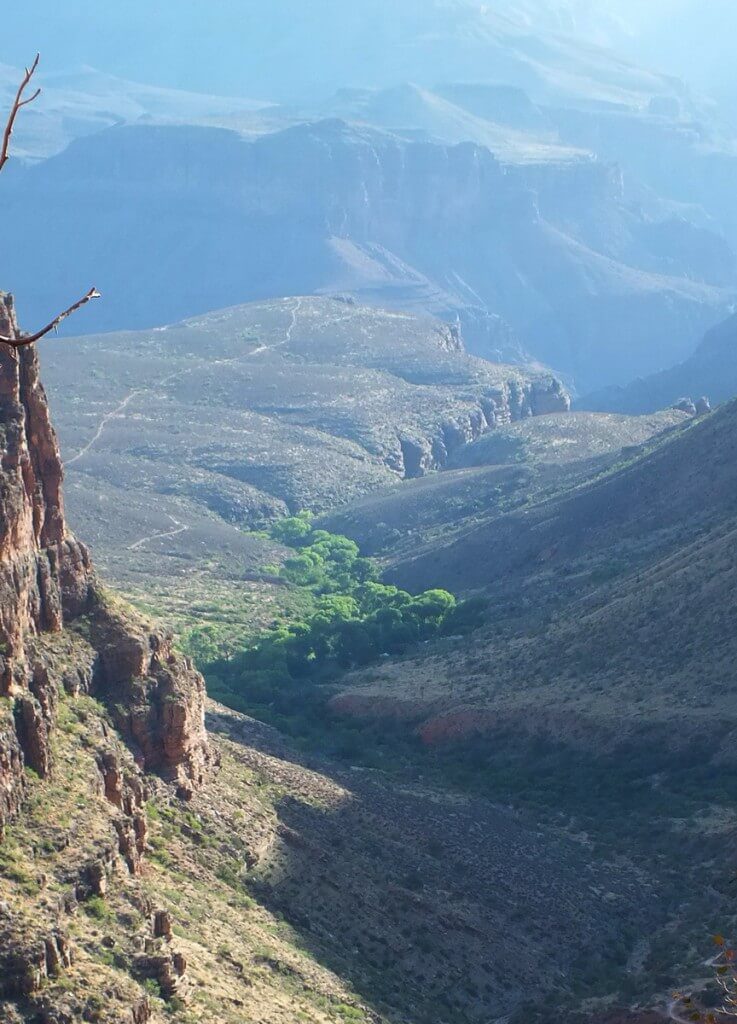
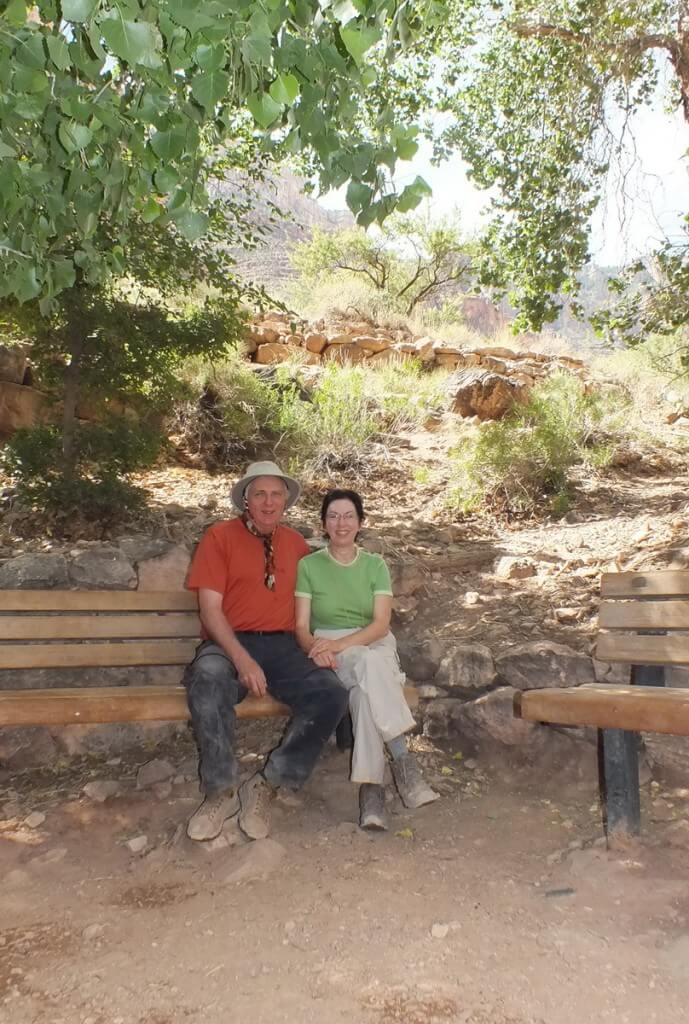
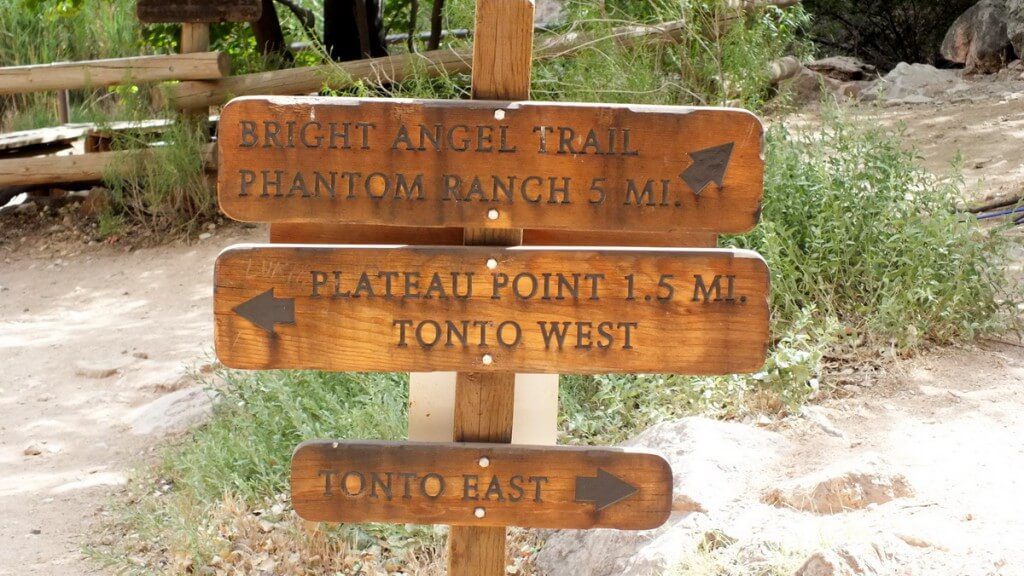
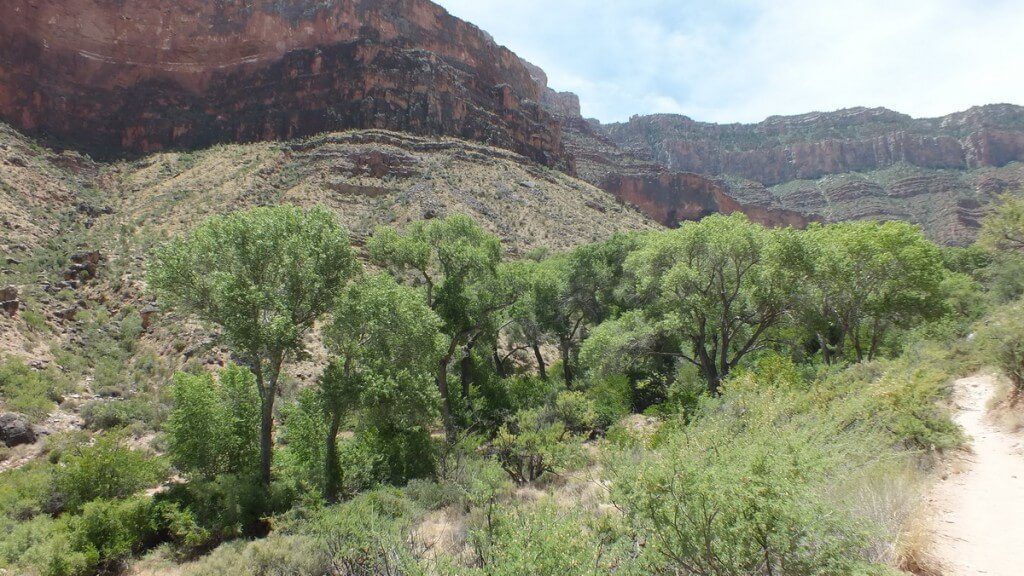
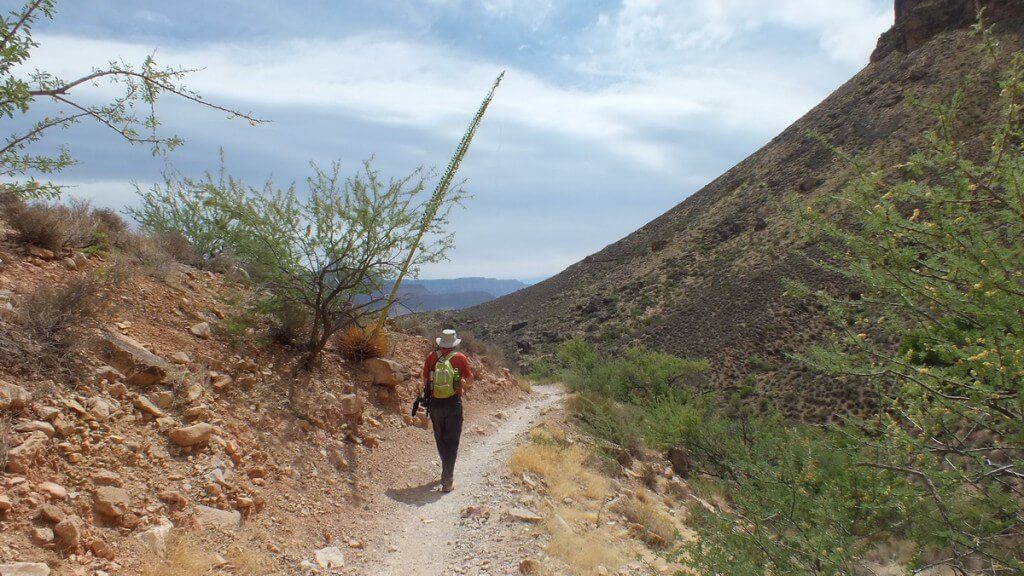
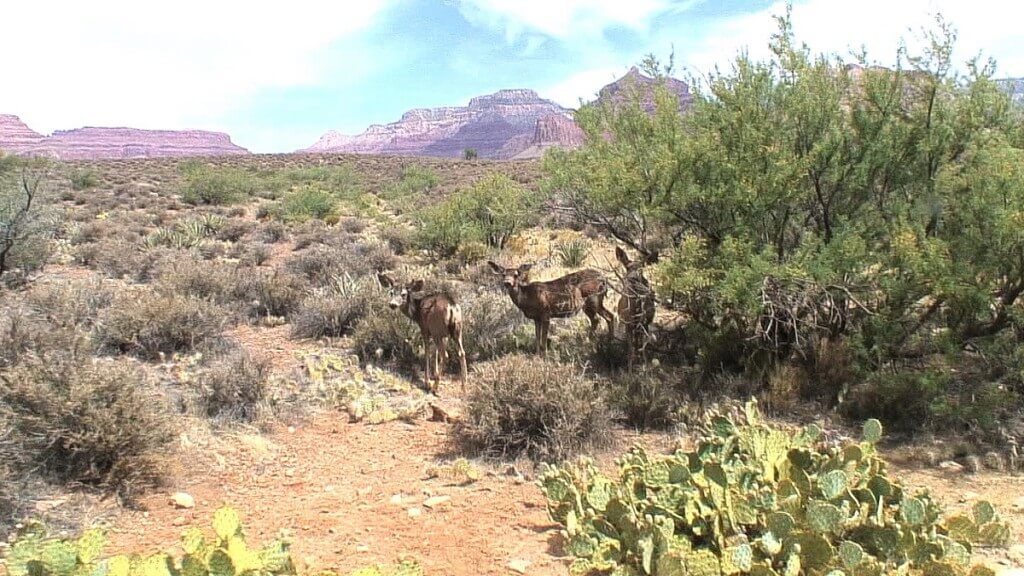

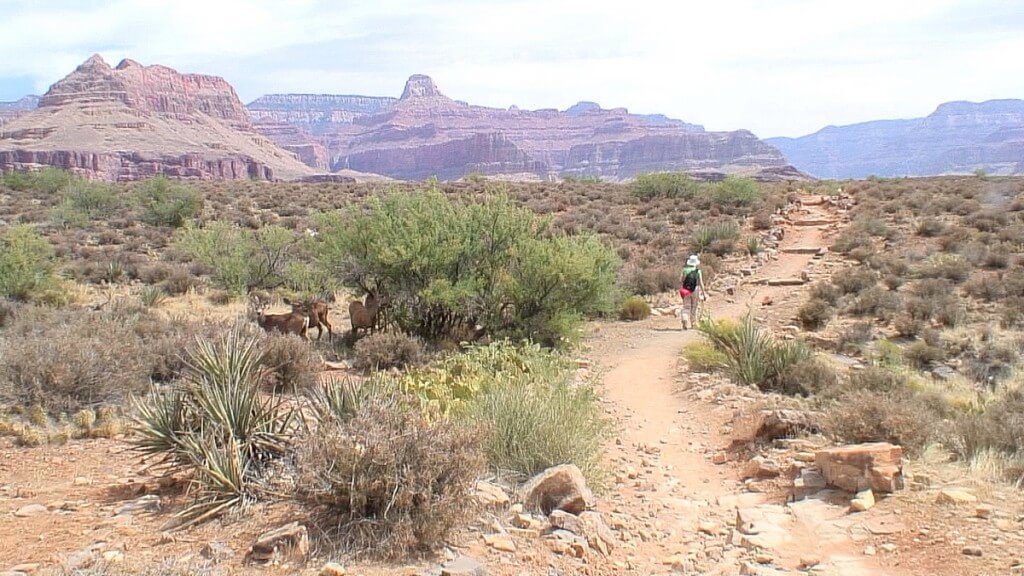
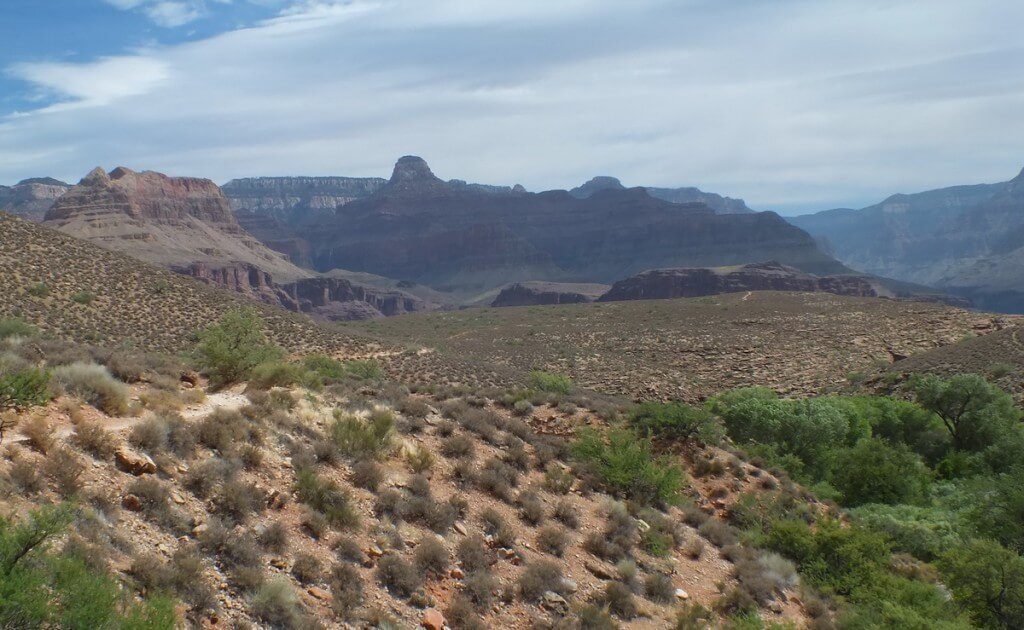
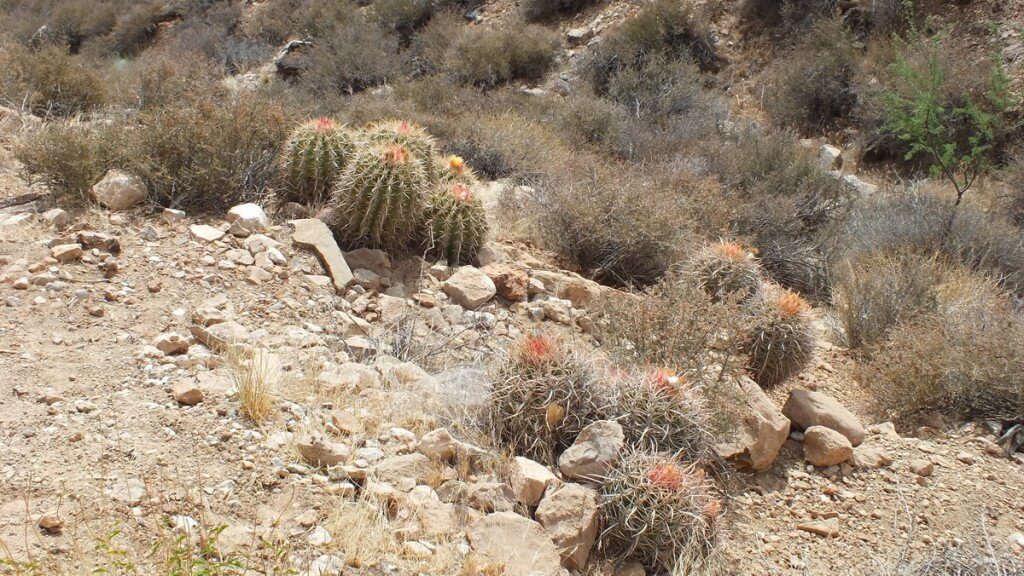
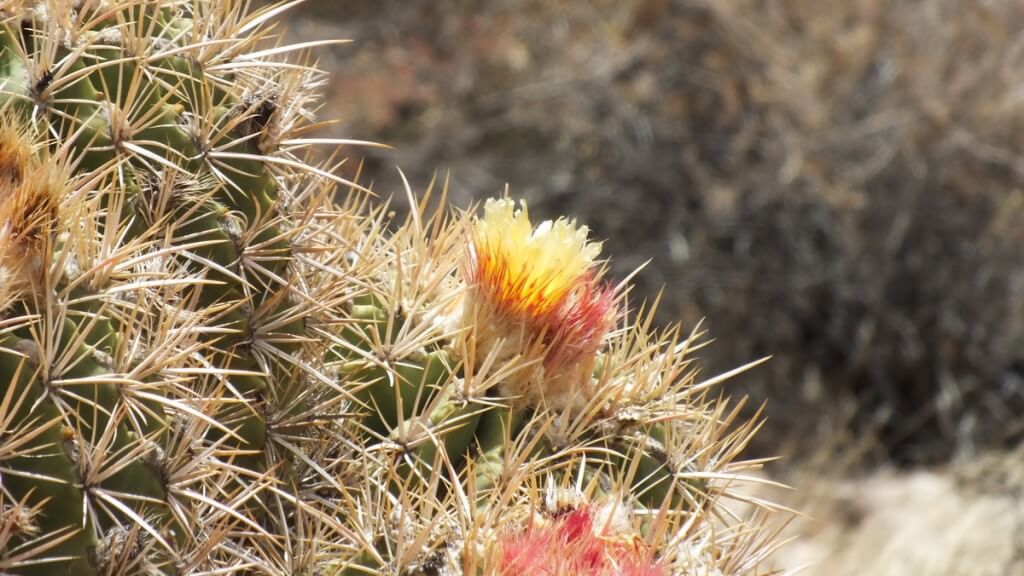
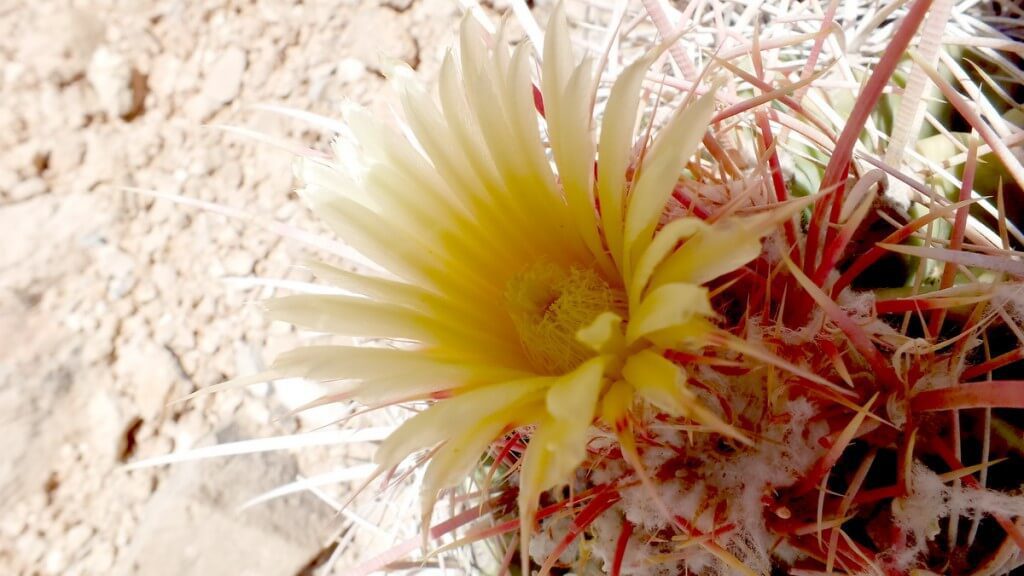
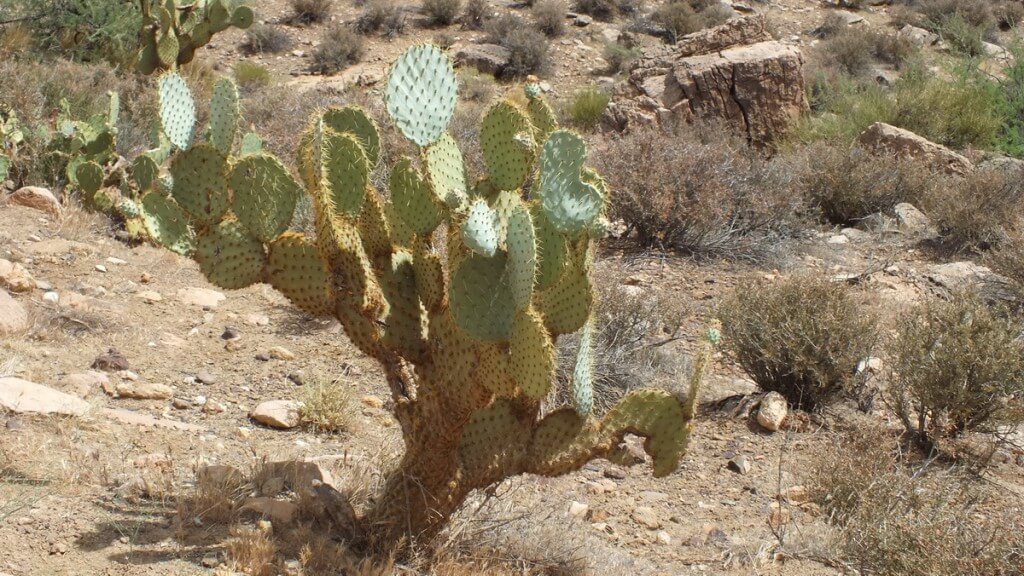


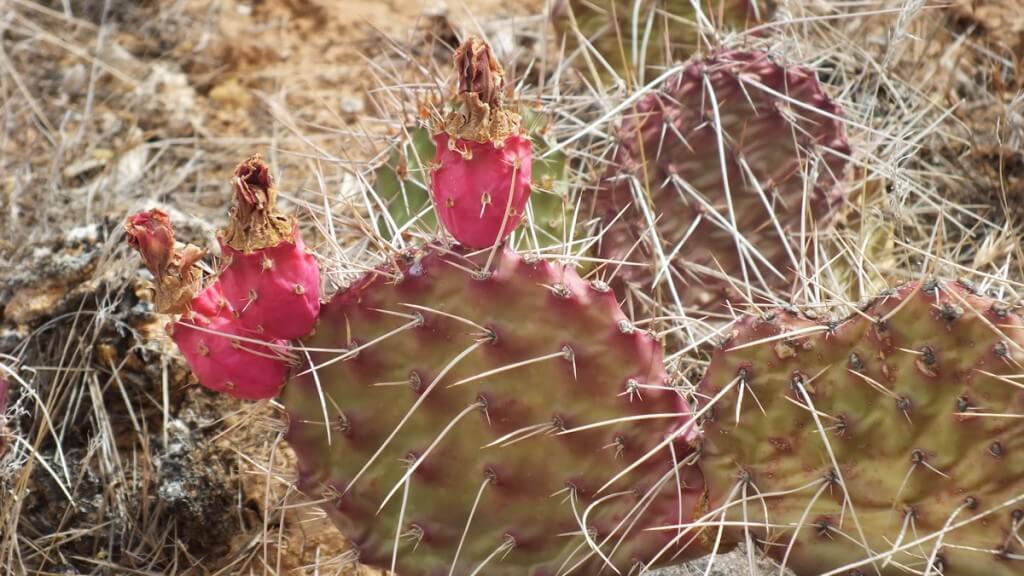
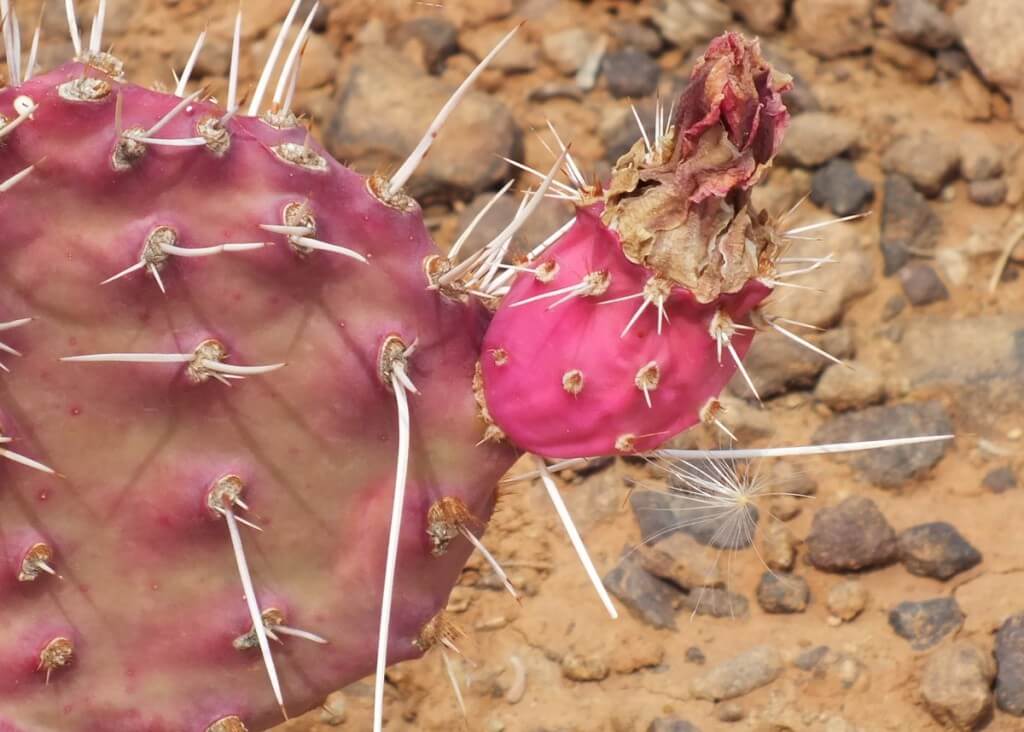
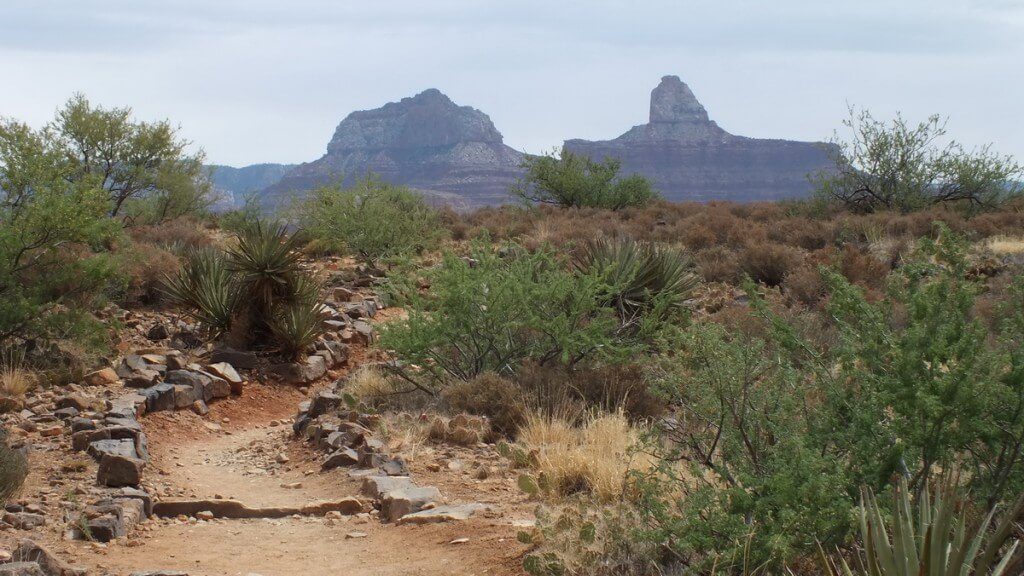
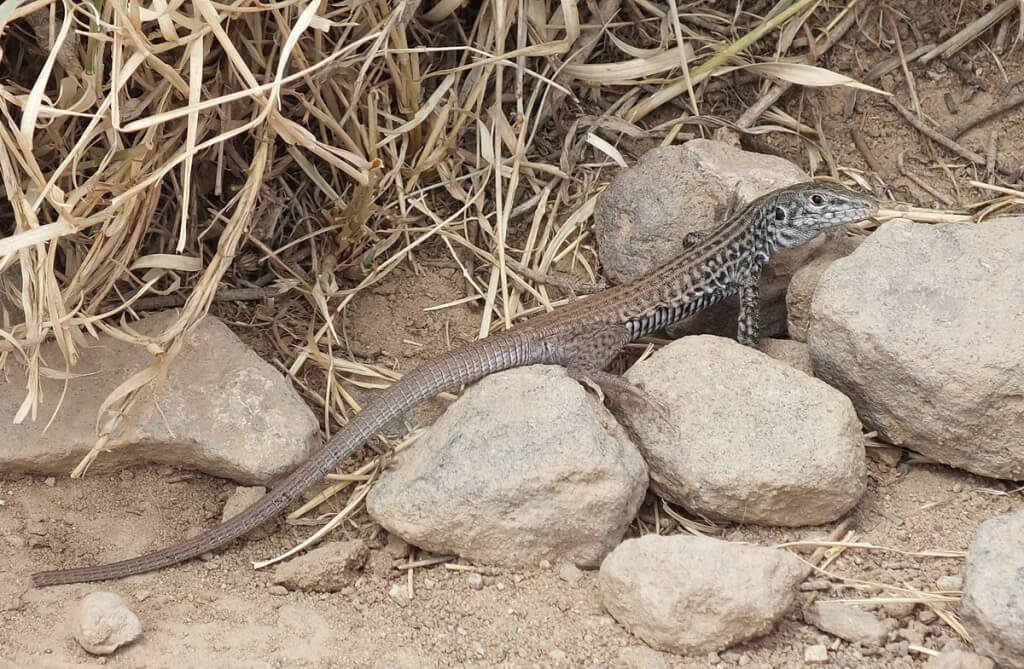
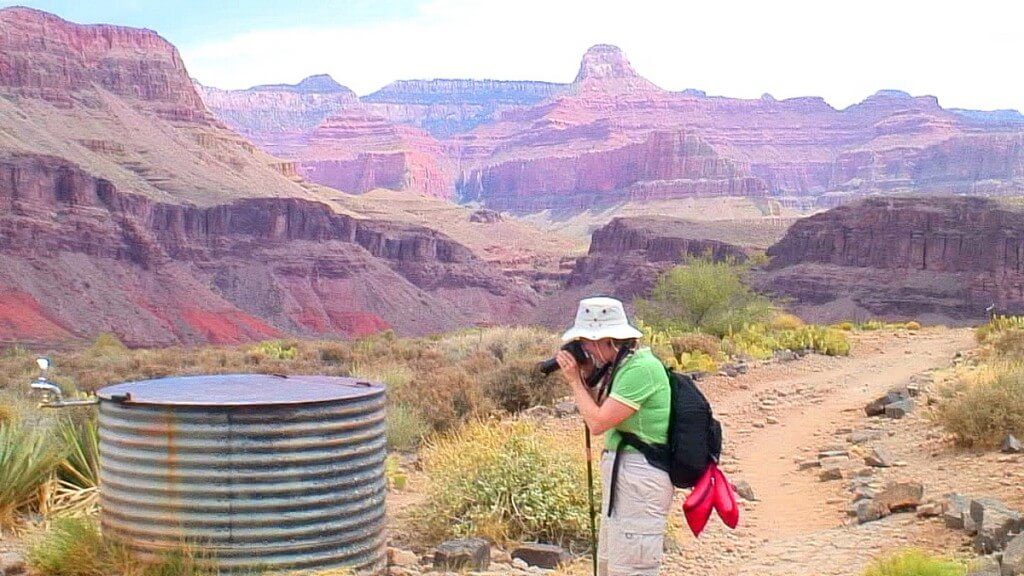
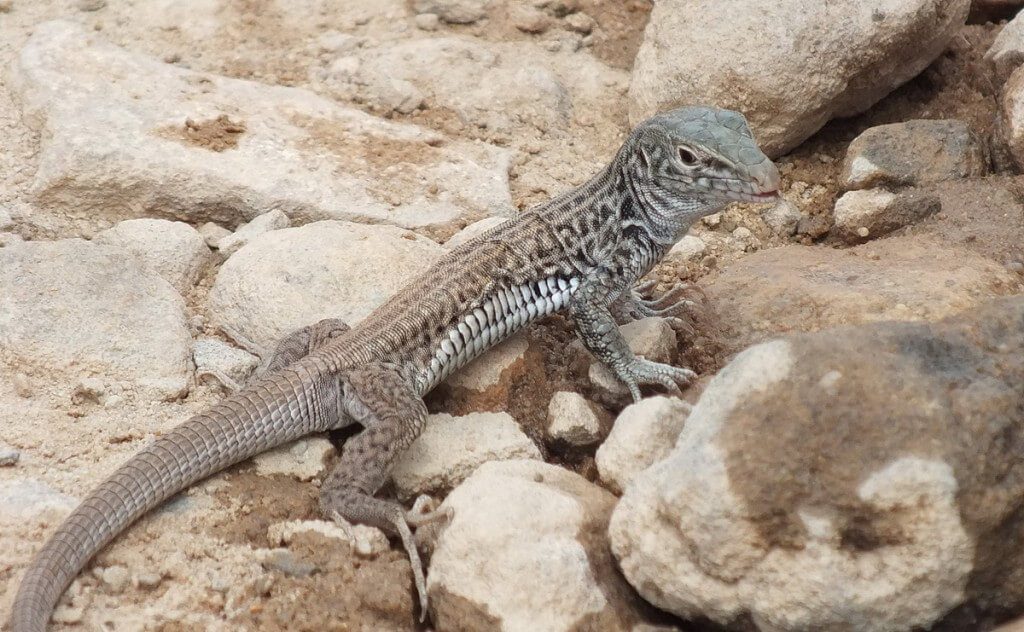

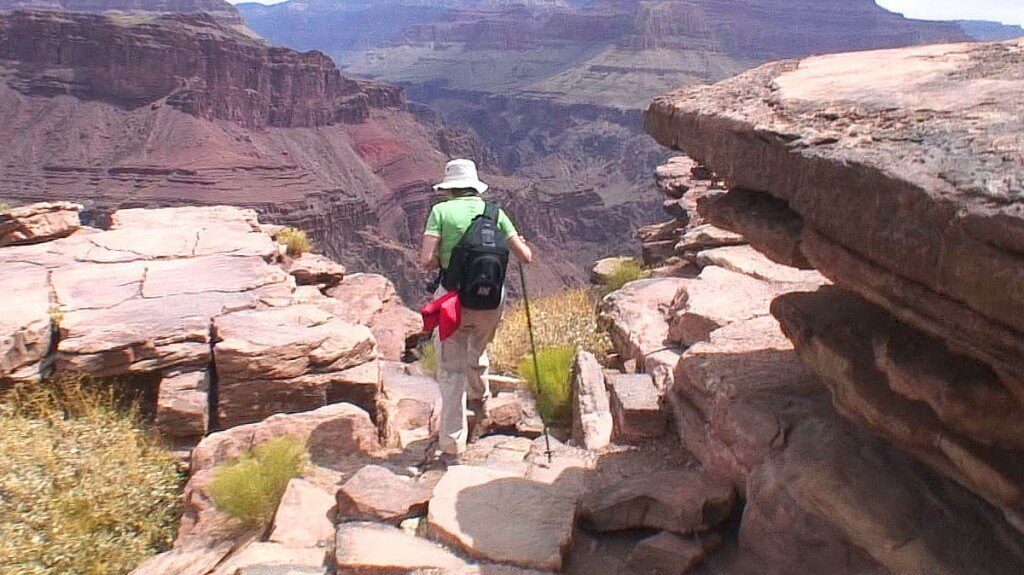
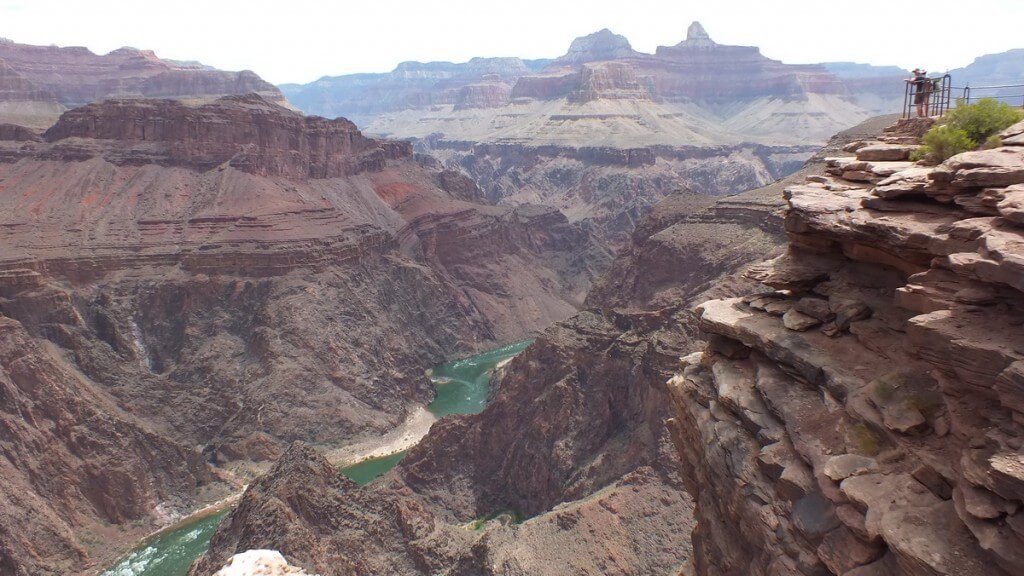
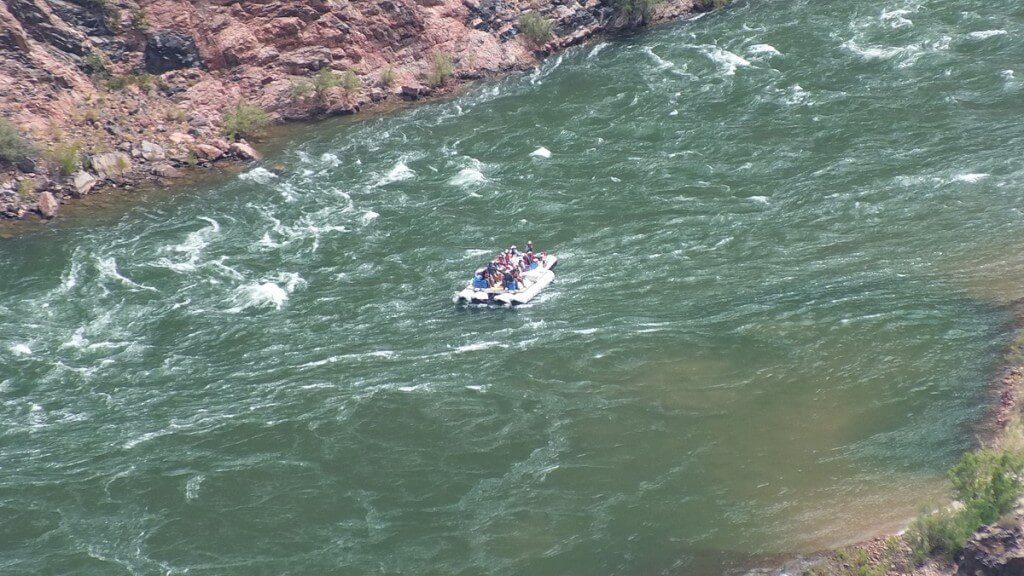
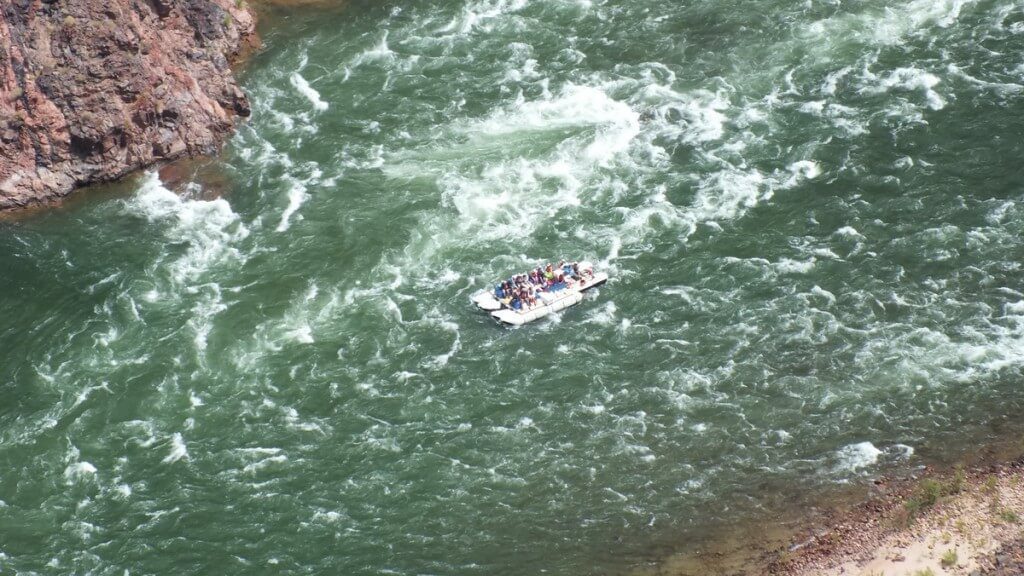
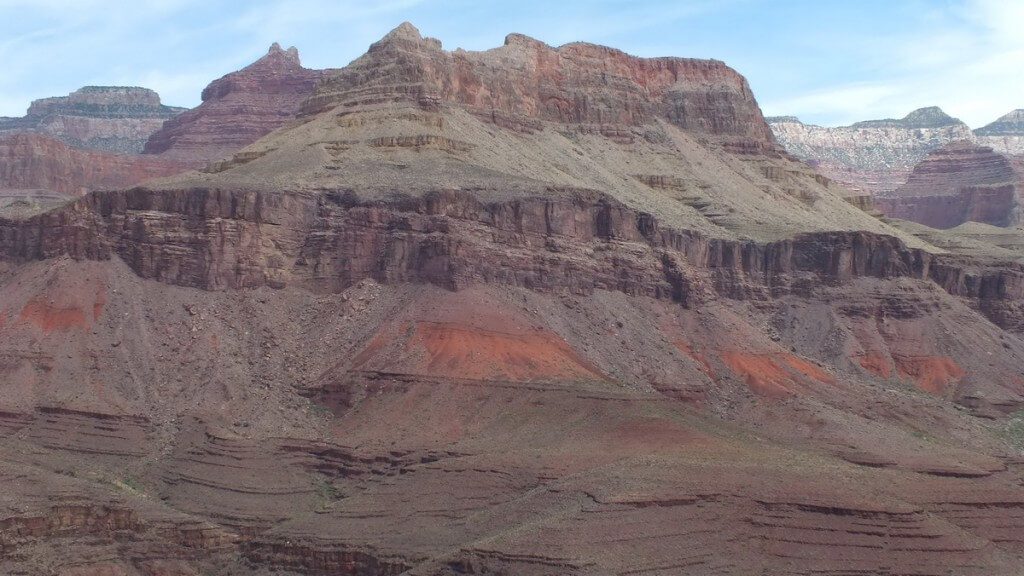
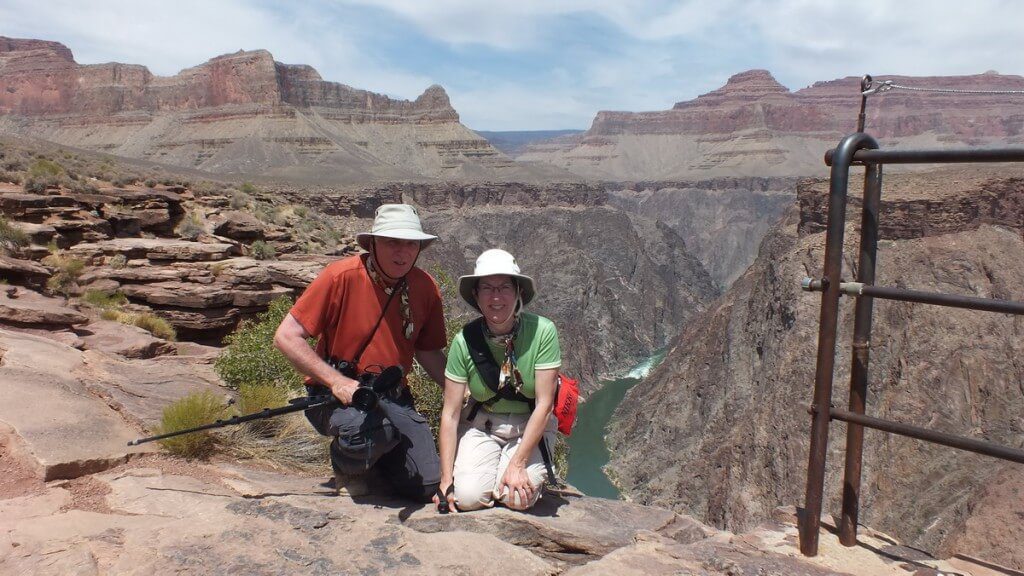
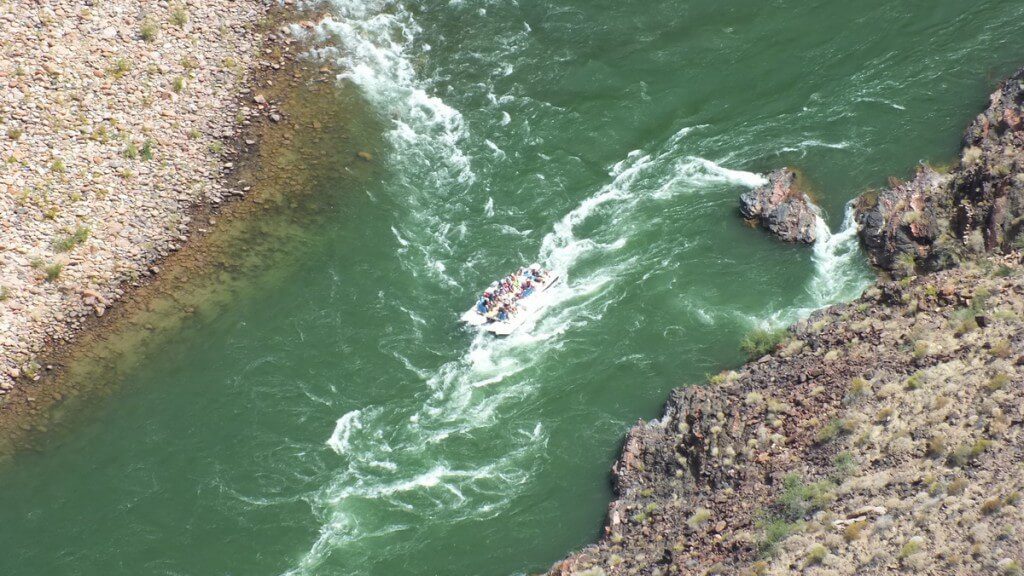
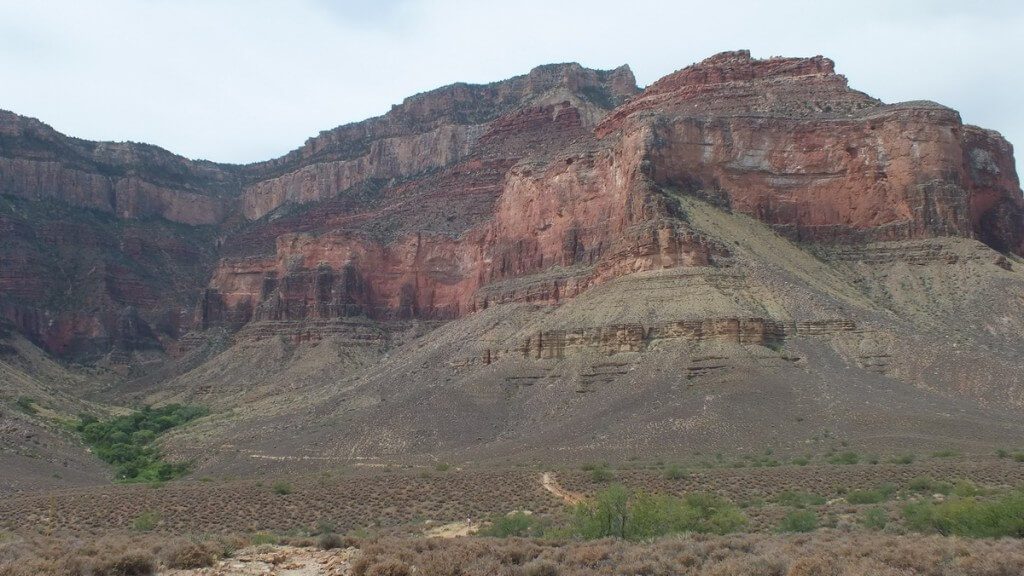

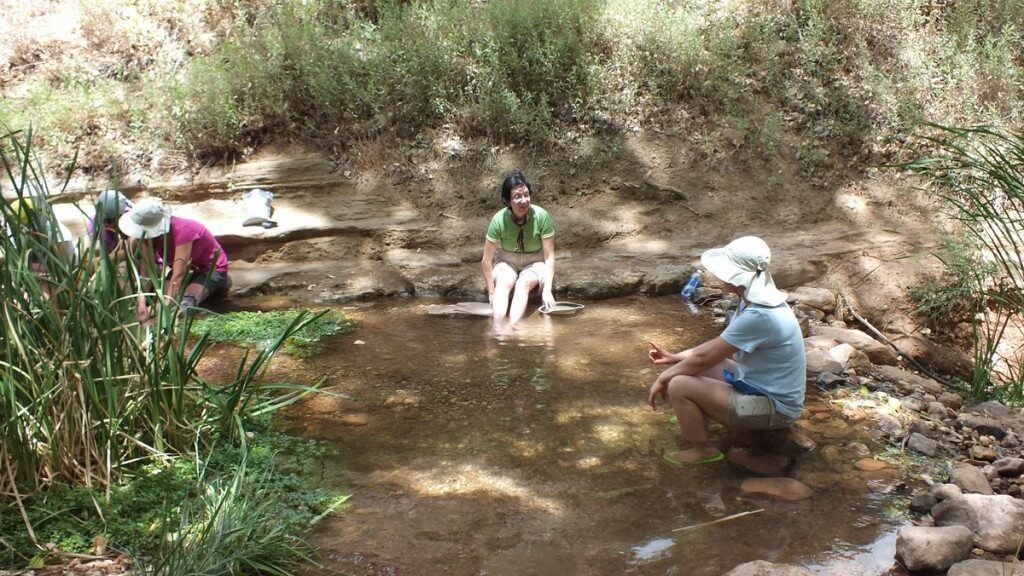
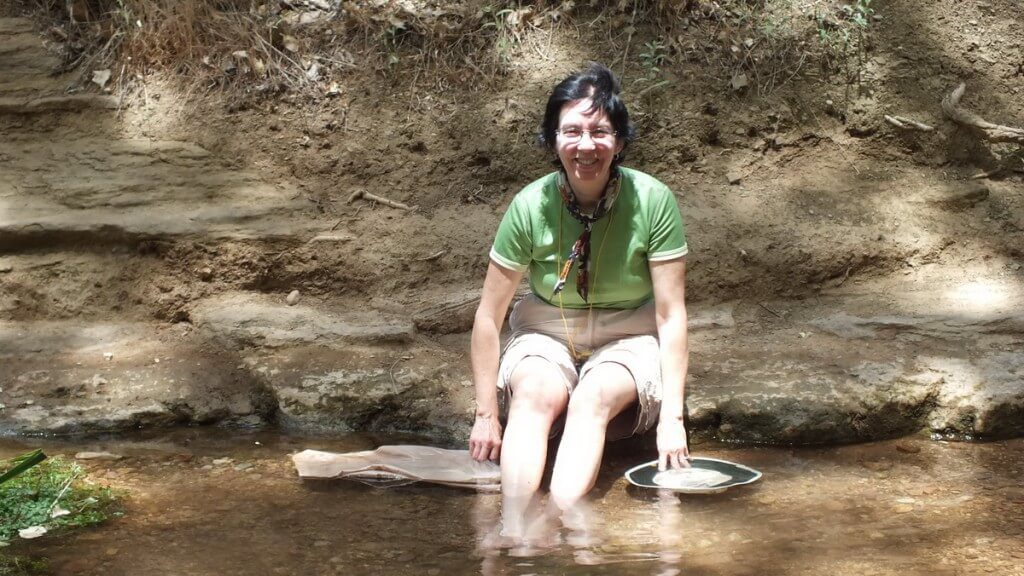
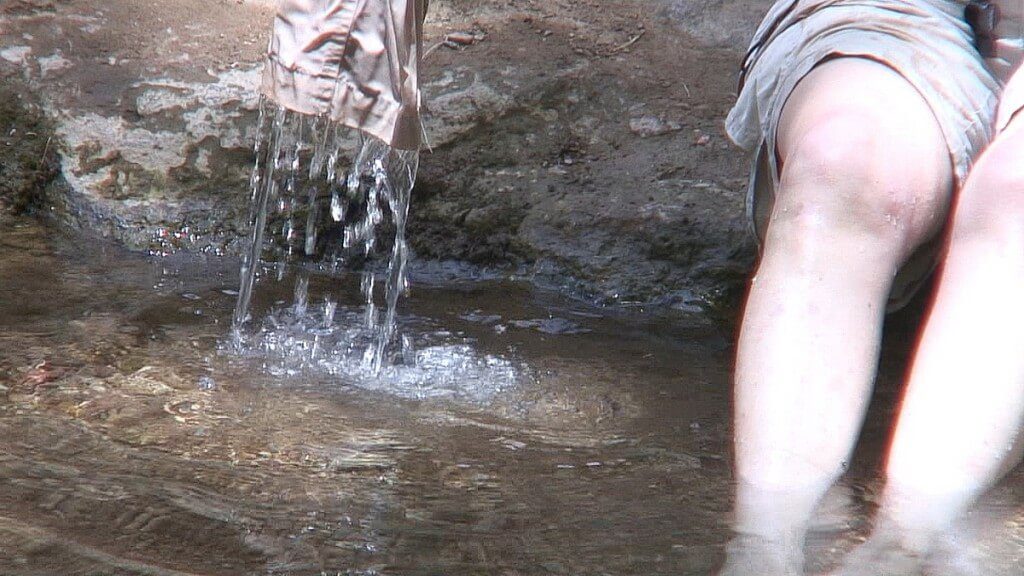
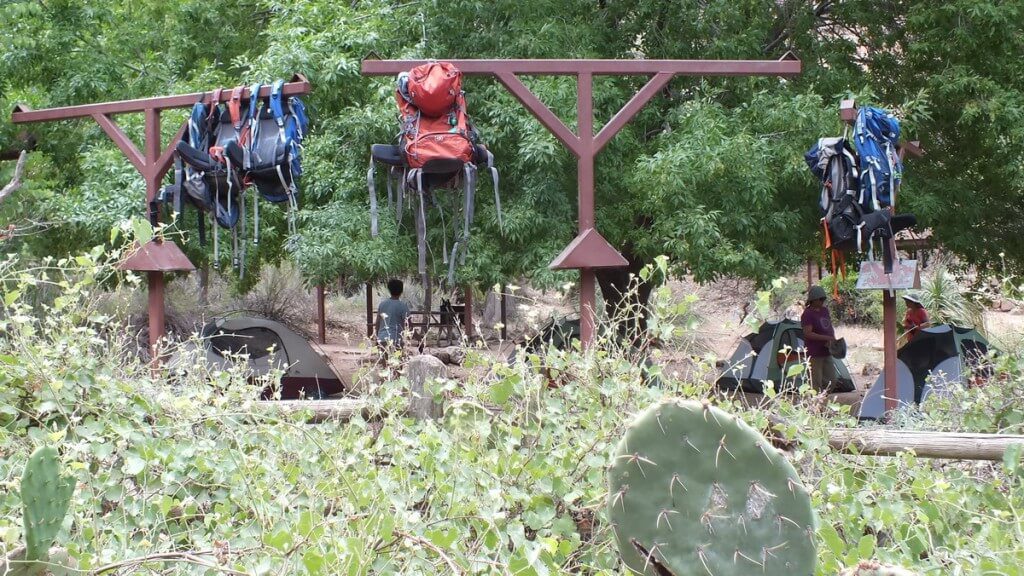
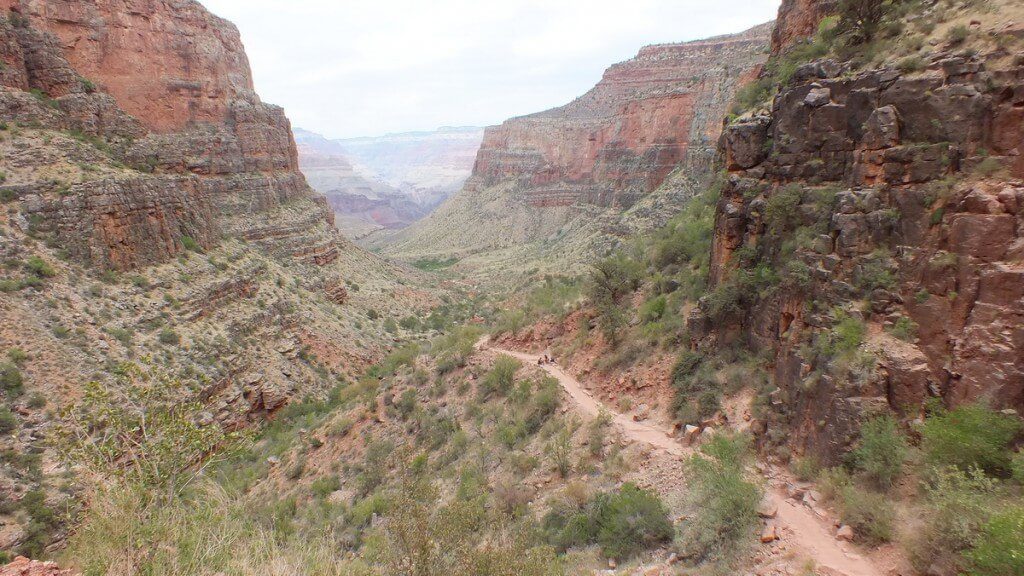
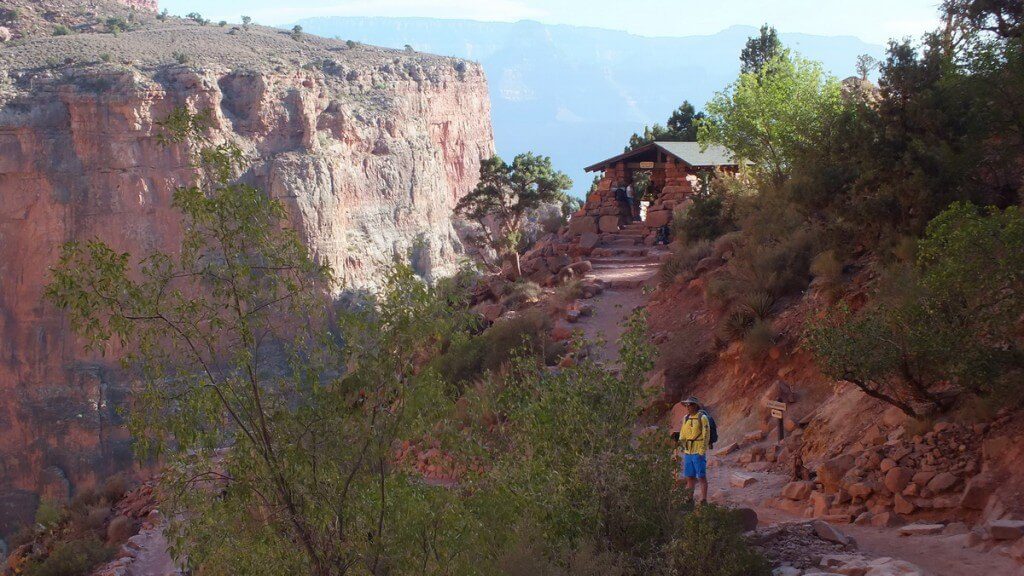
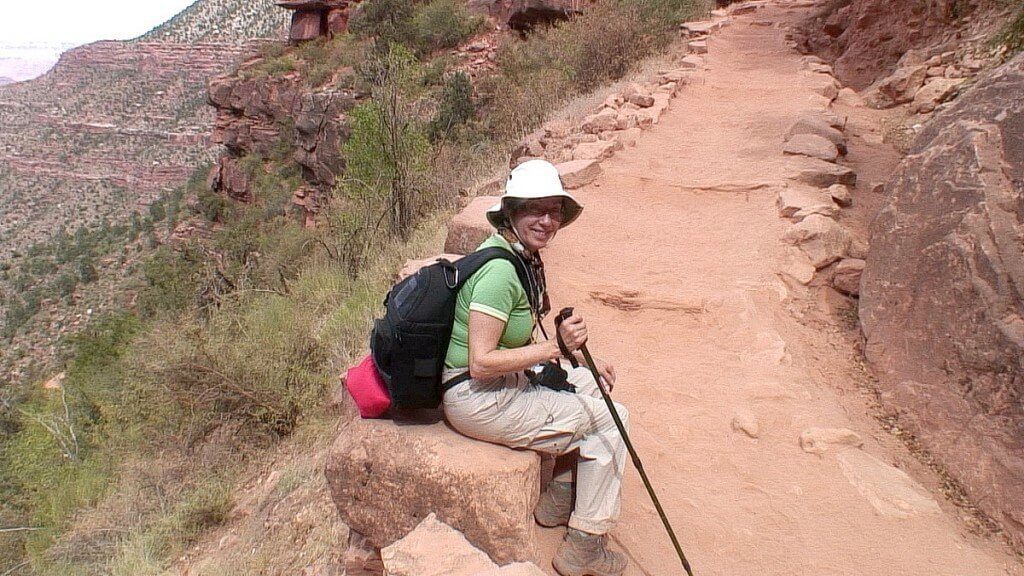
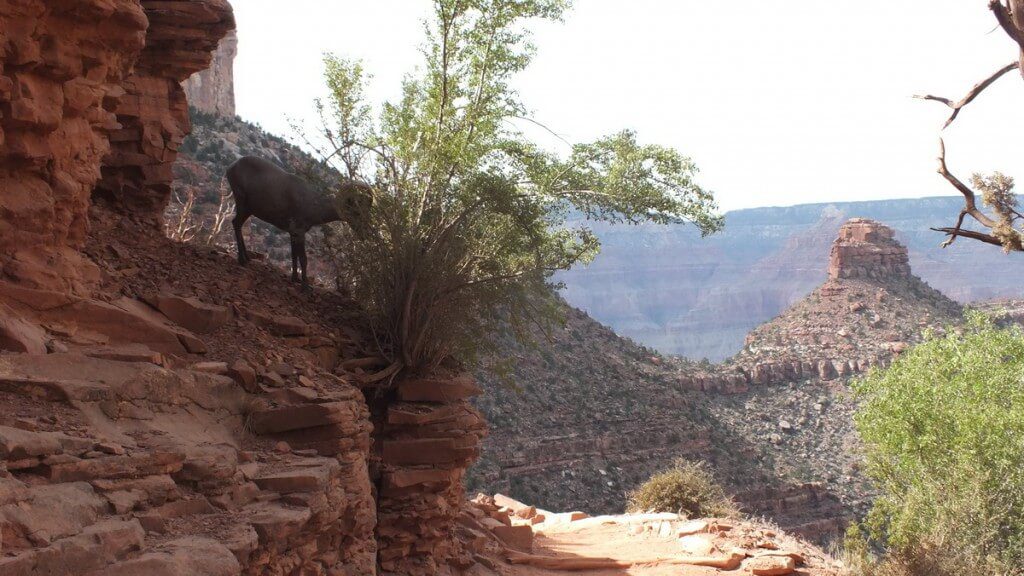
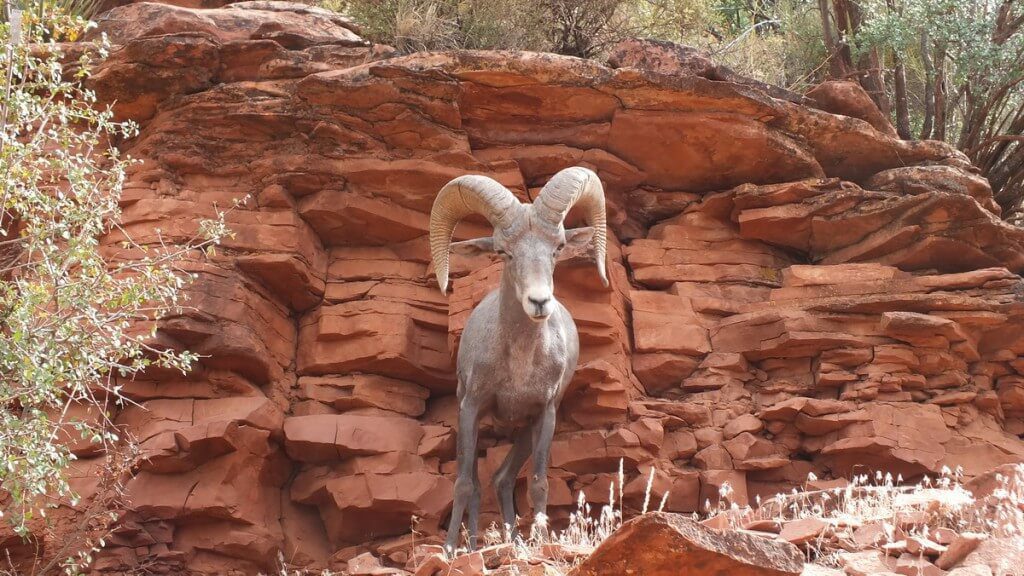
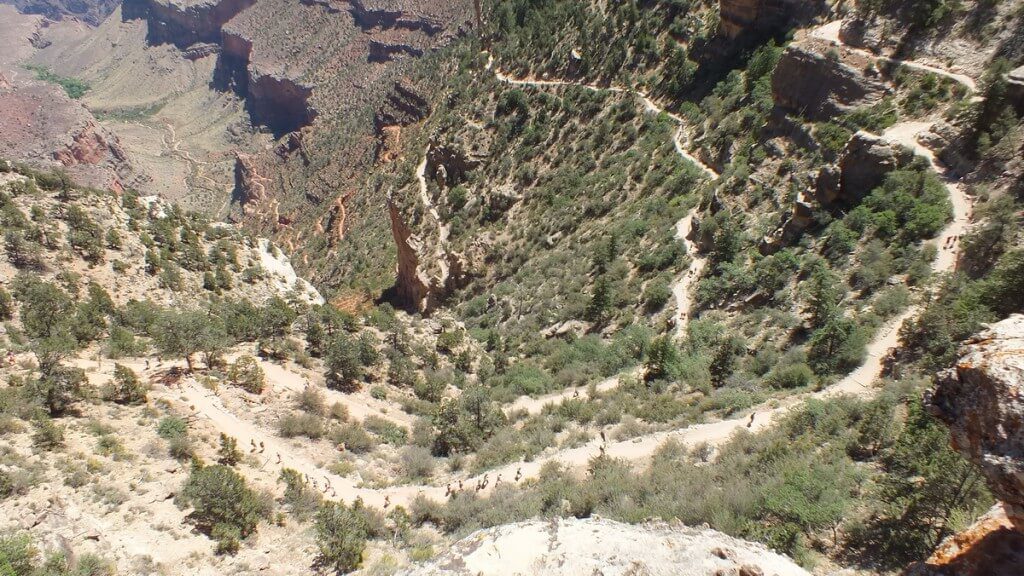


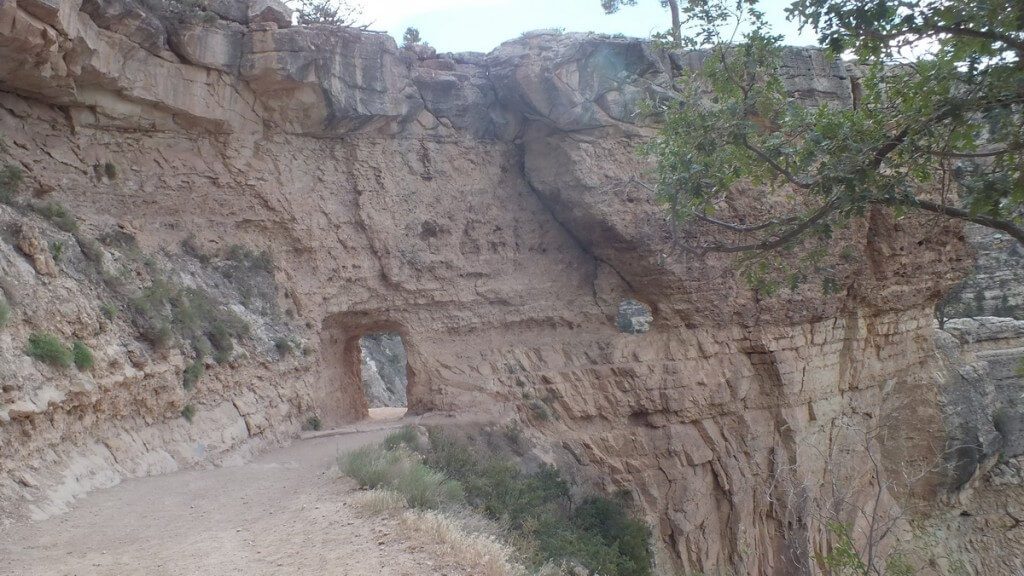
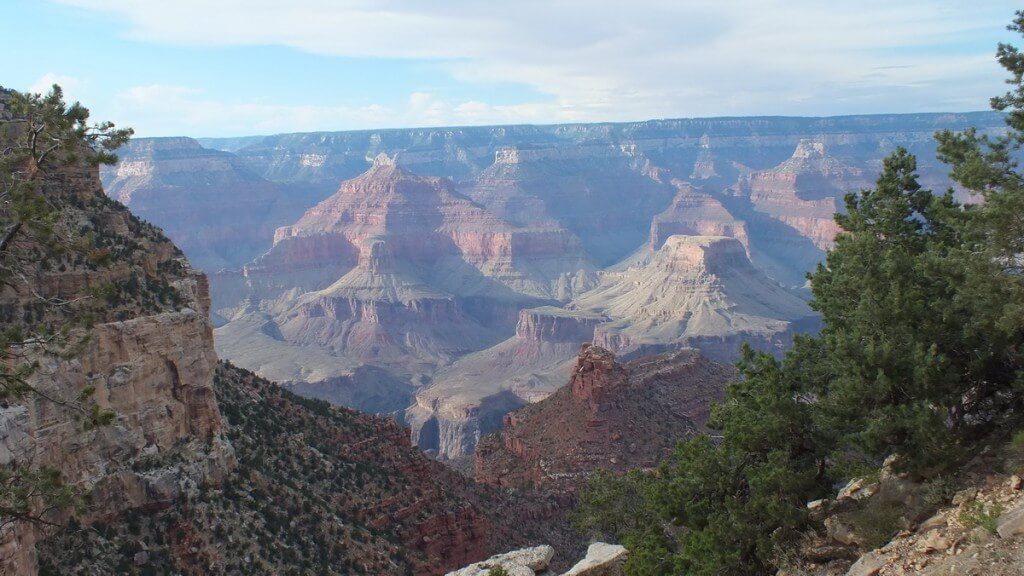
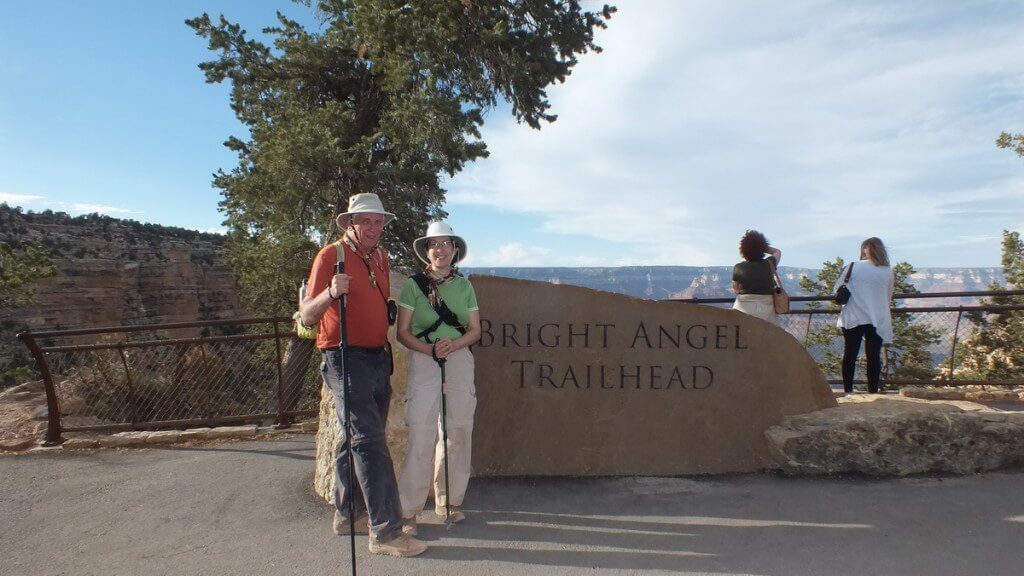
Just came across your blog and it brought back wonderful memories. My husband and I have hiked the south rim to Phantom Ranch twice. The last time to celebrate my 70th birthday. However, the most memorable hike was our rim to rim trek. We began on the north rim and friends started the hike on the south rim. At the bottom we exchanged car keys. We did our first hike in July and the lesson was learned that Spring and Fall are better choices. May you both enjoy many more breathtaking journeys on our country’s beautiful hiking trails.
I’m glad our blog triggered such fond memories for you, Marlene, and thanks for the good wishes. We do, indeed, hope to get back to the U.S. Southwest again sometime in the future. Not sure which location we’ll target next time, though.
Great information, best of adventures in the future!
Thanks for the good wishes, Mark. We do hope to enjoy good health and new adventures for a good many years yet to come. It makes life very interesting.
What a great trip report! I have been down to Phantom Ranch a few times, and always enjoy (?) the uphill march through IG and up the trail. At times the switchbacks seem to never end. Very nice photos and videos, especially the feet soaking! I do something similar in the Bright Angel Creek at Phantom; hikers just soak their whole body in the creek. Do you guys have anymore Big Ditch trips planned? I would like to do the South Kaibab, Tonto to Bright Angle loop someday. Cheers. (Next time, be sure to get an ice-cream).
Thank you for your comments. As a matter of fact, we have given thought to a return trip to the Canyon if only to experience another hike. South Kaibab Trail has peeked our interest. We’ll keep in mind the ice cream.
Great story and inspiration for the coming spring! Happy trails.
Thanks. Already, we are giving thought as to where we might venture next. A new year, a new opportunity, a new destination.
We always treat ourselves to a nice cream come when we reach the top!
that’s nice. We were too tired for that and needed something more substantial. A vegetarian pizza hit the spot and was our reward for a job well done. Thanks for reading our blog.
Great pics Guys, I could use some of that heat right now! 🙂
Thanks, Renee. I know what you mean. The frigid winter temperatures have been downright bone-chilling of late.
This blog post was so exciting to read.What a challenge to trek across open desert.The cacti photos were wonderful.Almost made me wish I was still teaching — I would have used your photos in a power point.Have a good Xmas the two of you.
What an amazing compliment! Thank you. And thank you for being a loyal reader of our blog. Merry Christmas back to you and your family. We are thankful to presently have snow and hope that it remains for over the holidays.